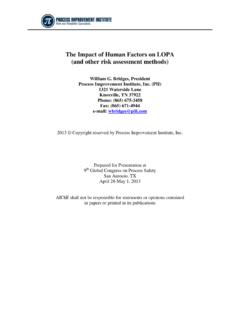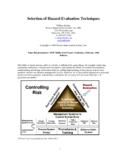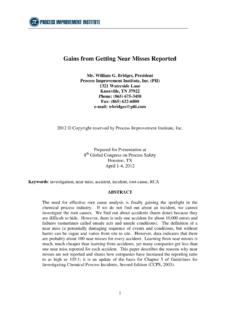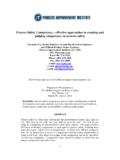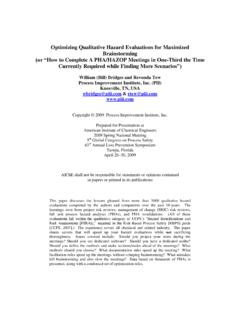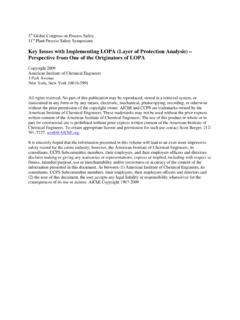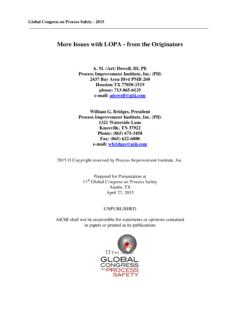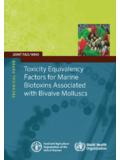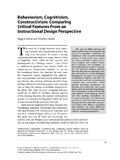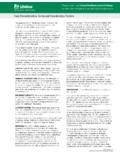Transcription of Human Factors Elements Missing from Process …
1 Human Factors Elements Missing from Process Safety Management (PSM) By: William Bridges & Revonda Tew Process Improvement Institute, Inc. (PII) 1321 Waterside Lane Knoxville, TN 37922 USA +1-865-675-3458 Copyright 2010 Process Improvement Institute, Inc. Prepared for Presentation at American Institute of Chemical Engineers 2010 Spring Meeting 6th Global Congress on Process Safety and the 44th Annual Loss Prevention Symposium San Antonio, Texas March 22-24, 2010 2 Keywords: Human Factors , Process safety, PSM, Human error, risk-based Process safety, RBPS Abstract Process safety is about controlling risk of failures and errors; controlling risk is primarily about reducing the risk of Human error. All Elements of Risk-Based Process Safety (RBPS) and alternative standards for Process safety (such as US OSHA s standard for Process Safety Management [PSM] or ACC s Process Safety Code [PSC]) have many Elements , and each of these in turn helps to reduce the chance of Human error or else helps to limit the impact of Human error.
2 But each Process safety standard has some weakness in the control of Human error. This paper presents an overview of Human factor fundamentals, discusses why many PSM systems are weak on Human Factors and outlines a comprehensive Process safety element on Human Factors . It describes what belongs in each category within the Human Factors element and explains the intent, content, and the benefit of each category. The paper also presents examples of Human Factors deficiencies and selected examples of industry practices for Human Factors control are provided. 3 Introduction All accidents (or nearly all, if you consider that there are some natural phenomena that we either cannot guard against of choose not to guard against) result from Human error. This is because humans govern and accomplish all of the activities necessary to control the risk of accidents.
3 Humans influence other humans in the Process not only do humans cause accidents (unintentionally) by making errors directly related to the Process itself, but they also cause errors by creating deficiencies in the design and the implementation of management systems ( , we make errors in authorities, accountabilities, procedures, feedback, proof documents, continual improvement provisions). Ultimately these management systems govern the Human error rate directly contacting or directly influencing the Process . The Process -related activities where errors have the most influence include: Designing of a Process Engineering of a Process Specifying the Process components Receiving and installing equipment Commissioning Operating the Process Predicting safeguards necessary to control the risk at an acceptable level and sustaining these safeguards for the life of the Process Maintaining, inspecting and repairing the Process Troubleshooting and shutting down the Process Managing Process Changes Recent major accidents have highlighted the need for increased focus on Human Factors .
4 The US Chemical Safety Board (CSB) cited Human factor deficiencies as one of the main contributors of the catastrophic accident at the BP Texas City Refinery in March 2005. The Human factor deficiencies included lack of control of worker fatigue, poor Human -system-interface design, poor communication by radio/phone, out-of-date and inaccurate operating procedures, and poor (no) communication between workers at shift handover. The CSB cited similar issues from many other accidents and has urged industry and the US OSHA (the regulator) to pay much more attention to Human Factors . As a result, the recent US OSHA National Emphasis Program for Refineries included Human Factors as one of the 12 core Elements it reviewed in detail across many of the 148 oil refineries in the USA. Implementing Human factor engineering and policies to prevent accidents is not a new concept.
5 Nearly all (or all, from a more complete perspective) of the causes and root causes of major accidents in the past 30 years have been the result of poor control of Human Factors . This has been cited in many root causes analysis reports and papers concerning these major accidents. Process Safety Management (PSM) systems based on OSHA s PSM standard are likely lacking the fundamental Human factor standards that if applied across the applicable PSM Elements , would work together to reduce Human error. The newly developed Risk Based Process Safety industry standard from the CCPS/AIChE does contain the Human factor standards, but these are presented under several PSM 99% of accidental losses (except for natural disasters) begin with a Human error (supported by data from more than 1500 investigations)Root causes of accidents are management system weaknesses(Center for Chemical Process Safety, American Institute for Chemical Engineers, Guidelines for Investigating Chemical Process Incidents , 2003) OSHA agreesWeak Management Systems Human ErrorHuman Error AccidentsAccidents 4 Elements instead of under a stand-alone Human factor element.
6 This guideline does not provide a needed road map to help companies transition to RBPS from the minimum PSM systems defined in OSHA s PSM standard. A starting point for this transition should be implementing a Human factor element comprised of the Human factor categories Missing from most PSM systems (especially from those based on the OSHA PSM standard). Definitions for Use in This Paper This paper will use the term Human Error to mean the errors that are made during direct interface or direct influence of the Process . Human Factors are those aspects of the Process and related systems that make it more likely for the Human to make a mistake that in turn causes or could cause a deviation in the Process or could in some indirect way lead to the increased probability of an accidental loss. Management systems are the administrative controls an organization puts in place to manage the people and workflow related to the Process under consideration, and so these inherently attempt to control Human Factors Human Error Fundamentals Types of Human Error In simplest terms, there are only two types of Human error: Errors of Omission (someone skips a required or necessary step) and Errors of Commission (someone performs the step wrong).
7 But in addition, these errors occur either inadvertently (unintentional error) or they occur because the worker believes his or her way is a better way (intentional error, but not intentional harm). Intentional errors can usually be thought of as errors in judgment. Some believe a lack of awareness of the risk causes these errors, but in actual practice, the worker who commits an intentional error is well aware of the risk. They instead believe they know a better way to accomplish a task or they believe there are already too many layers of protection (so bypassing one layer will not cause any harm). Regardless of type or category of Human error, the organization can and should exert considerable control of the errors. 5 Relationship of Control of Human Error to Control of Risk from an Activity or Process A Process is a combination of the utilities, raw materials, and Human actions (direct actions and those actions involving programming the Process to accomplish automatic functions).
8 If anything goes wrong with these Inputs, or if there are basic design flaws or basic fabrication flaws in the Process , then the Outputs will not be desired. The desired output is acceptable (or high) production rates at acceptable or higher quality Factors with no harm to the humans (long term or short term), no harm to the environment, and with acceptable (or higher) life of the Process components. The negative outcomes resulting from humans failing to control the raw material quality, failing to control the utility levels consistently, making errors directly related to the operation of the Process , or making errors in the care of the Process (such as maintenance) will result in lower production, lower quality, higher number and severity of safety-related accidents, and more negative impact on the environment.
9 The potential (probability) of the negative outcomes is collectively referred to as business risk more precisely, the risk is a product of the likelihood of one or more of these negative outcomes and the severity of each outcome. A critical concept is therefore: In order to sustainably control the risk of a complex Process (such as an oil/gas operation, refinery, chemical plant, steel plant, automobile manufacturing, aircraft manufacturing, etc.), the organization must design and implement management systems to: Understand the Risk This involves predicting problems; which in turn includes predicting the risk of possible accident/loss scenarios, establishing the appropriate design and the right layers of protection to control risk to a tolerable level Control Risk Factors Day-to-Day This involves controlling the original design by maintaining the established layers of protection and managing changes to the design using integrated management systems Analyze Actual Problems and Determine Weaknesses in the System This involves identifying weaknesses in designs and management systems and weaknesses in risk understanding through root cause analysis of actual problems (losses and near-losses) If an organization does not directly control risk, the organization cannot directly control quality, safety, environmental impact, or production to acceptable levels.
10 An organization must sustainably control Human error to manage the risk of accidental losses that impact quality, safety, the environment, production, or assets. 6 Process Improvement Institute, Inc. (2004-2010) Management systems control the interaction of people with each other and with processes. They are the high level procedures we use to control major activities like conducting PHAs, management of change, writing operating procedures, training employees, evaluating fitness for duty, conducting incident investigations, etc. If management systems are weak, then layers of protection will fail and accidents will happen. To reiterate, accidents are caused by Human error. In general, Process Safety Management (PSM) is focused on maintaining these Human errors at a tolerable level because: All accidents happen due to errors made by humans; including premature failure of equipment.
